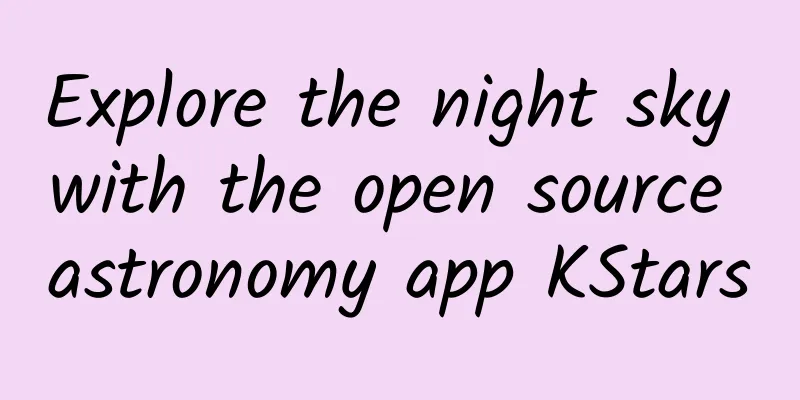Explore the night sky with the open source astronomy app KStars

|
Gaze at the stars from your Linux desktop or Android device with KStars. I have always been fascinated by the night sky. When I was young, the only reference materials available were books, which seemed to depict a different sky than the one I saw from home. More than five years ago, I wrote about my experience using two open source planetarium apps, Celestia and Stellarium. Recently, I learned about KStars. It is an amazing open source app that helps children (and adults) engage in science and astronomy. Its website says: “KStars is free, open source, cross-platform astronomy software. It provides an accurate graphical simulation of the night sky from any location on Earth, at any date and time. Displays include up to 100 million stars, 13,000 deep sky objects, all 8 planets, the Sun and Moon, and thousands of comets, asteroids, supernovae, and satellites.” KStars is part of the KDE Education Project. The latest version, available for Linux, Windows, and MacOS, integrates StellarSolver, a cross-platform SExtractor program that can build a catalog of objects from astronomical images. Install KStarsKStars is freely licensed under the GPL 2.0 protocol. The source code can be viewed at the official KDE GitLab instance (a read-only mirror of GitHub). The KDE Education Project has excellent installation documentation. I use Pop!_OS and can find this app in Pop!_Shop. KStars can be installed on Linux from your distribution's software repository. On Android devices, KStars Lite for Android can be downloaded from the Google Play Store. The KDE project maintains an excellent KStars manual to help users. Using KStarsAfter installation, launch the program from your Applications menu. The startup wizard will guide you through the initial setup. KStars Startup Wizard The instructions were easy to follow. The wizard will prompt you to set the location of your home. Unfortunately, my little village was not listed, but a larger community nearby was. KStars Location Settings You can also download additional data and extra features for the program. KStars Extension There are a lot of options available here. I selected "Common images displayed in the detail window". Once you've set it up, KStars will present you with a map of the night sky based on your location. KStars Night Sky Display The current time zone is shown in the upper left corner (in this picture it is 5:58 p.m. on November 30, 2020). Using the left mouse button, you can move the display left, right, up, and down. You can zoom in and out using the mouse wheel. Place the mouse cursor over a celestial object and right-click to view a description of the current object. KStars Description participateKStars is actively seeking help with bug reports, astronomy knowledge, code, translations, etc. The main developer and maintainer is Jasem Mutlaq. If you would like to contribute, please visit the project website or join the mailing list to learn more. |
>>: Xigua Video iOS Voice Over Accessibility Adaptation Practice
Recommend
Digital camera sales hit a new low, replaced by smartphones
Last month, the Camera and Imaging Products Associ...
The logic behind the discrimination against programmers who graduated from training institutions
[[157375]] Nowadays, there are many IT training i...
China Automobile Dealers Association: Used Car Weekly Report from November 8 to 14, 2021
1. Weekly transaction trend of used cars in Novem...
100% Method to Create a Hot Short Video Account
In the era of attention economy, short videos hav...
The most comprehensive Android app market free resource application details in history!
This is the most comprehensive guide to applying ...
Xcode 7: Test your app on a real device without spending $99
In Xcode 7, Apple changed its licensing policy. P...
The "Bio Purge" has begun. Can you escape the extinction apocalypse?
Mixed Knowledge Specially designed to cure confus...
Wild watermelon seedlings are neither watermelons nor seedlings.
Speaking of wild watermelon seedlings Hibiscus tr...
The practical effect of VR virtual technology that can raise funds and go public
A year ago, after Facebook spent a lot of money t...
Windows 8/8.1 is growing rapidly: XP is on the way out
According to the latest statistics from market re...
WOT2016 Wang Qingyou: Listen to the Chief Architect Discussing Large APP Server Architecture
The WOT2016 Mobile Internet Technology Summit wil...
APP promotion and operation: How to maximize the effect of your activities?
APP promotion is believed to be a major problem t...
Do you have a computer? Turn it on and join the research on the new coronavirus!
As long as you have a computer with internet acce...
What are the promotion strategies for Baidu's mobile bidding? Things to note when promoting on mobile devices!
Detail 1: Target customers search at different ti...
Wuhan University Sakura live broadcast schedule announced: When will it start and end? Attach specific time
March every year is the season to go to Wuhan to ...









